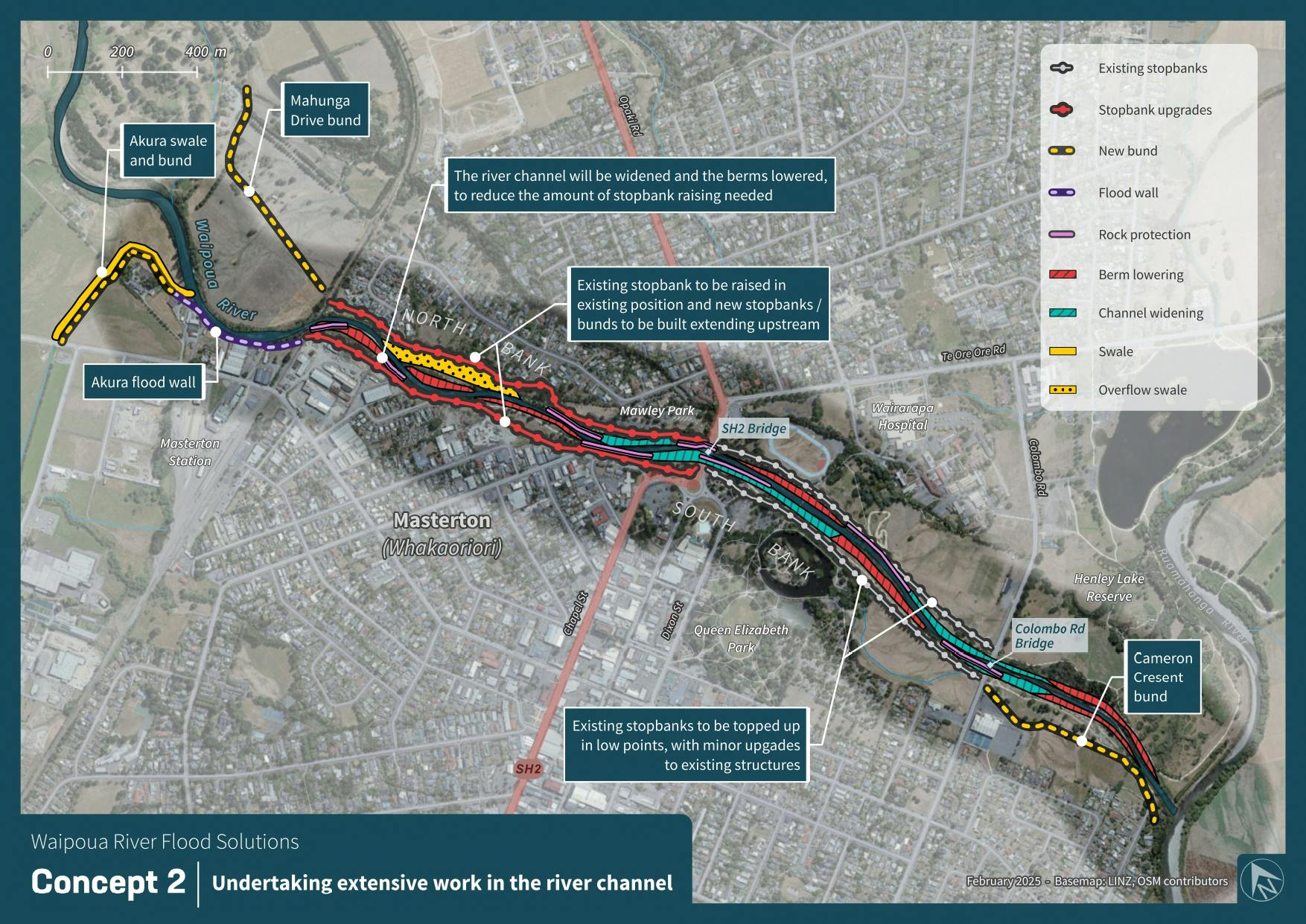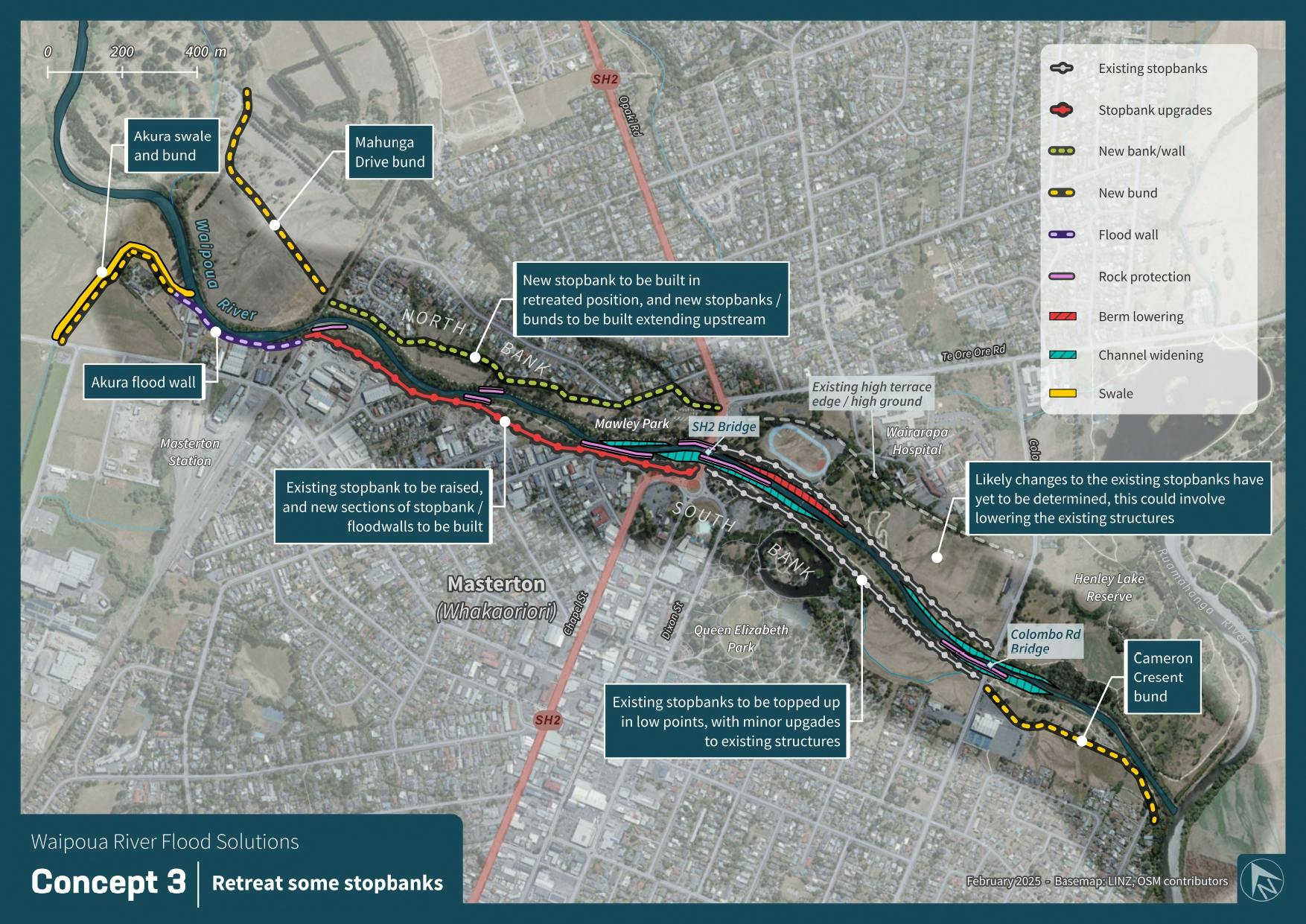Waipoua River flood management concepts for Masterton
Consultation has concluded
Flooding impacts more people, more often than any other natural disaster in the Greater Wellington region. We're looking at the possible impacts of flooding from the Waipoua River to Masterton’s township and industrial areas. We’d like your feedback on proposed conceptsto help manage these risks.
The challenge
Masterton is at risk of flooding from the Waipoua River in a 1% AEP flood (that is a flood that has a 1% chance of happening in any given year). This flooding is worse when considering the predicted effects of climate change.
Finding flood risk management outcomes
Greater Wellington has been working alongside community members and mana whenua to explore ways to best manage the current and future flood risks to Masterton. The team has worked with experts, used the most-up-to-date technology, and collected as much data as possible to propose concepts to improve protection for the community from the impacts of flooding.
The final design for managing the flood risk will likely involve a combination of aspects from each of these proposed concepts.
We’d like to hear your thoughts on these flood risk management concepts for Masterton:
Concept One- Improve and extend existing stopbanks |
Concept Two - Undertake extensive work in the river channel Work along the river channel is proposed to increase the capacity for floodwaters through town. This concept would also require existing stopbanks to be upgraded, but they will not need to be as high as those proposed in Concept One. |
Concept Three - Retreat some stopbanks Stopbanks on the northern side would be retreated to give the Waipoua more room. Depending on the location, this could mean that Mawley Park, the Sports Bowl and/or sports fields may be at risk of flooding in large events. Existing stopbanks on the southern side of Waipoua River would still need to be upgraded. Stopbanks on the northern side would be retreated to give the Waipoua more room. Depending on the location, this could mean that Mawley Park, the Sports Bowl and/or sports fields may be at risk of flooding in large events. Existing stopbanks on the southern side of Waipoua River would still need to be upgraded. |
Concept Four - Nature-based solutions in the upper catchment This concept proposes to reduce the river flow through town. The type of nature-based solution is still being investigated. This concept would need to be implemented in conjunction with other flood management concepts. |
Complementary work
In addition to the four concepts, the project team has identified four work areas that will likely be needed to complement each of the four concepts. These are protection works at the bridges, bunds or stopbanks to protect the Oxford Street and Cameron Crescent areas, as well as a bund and swale (a depression that collects water and redirects it), to protect the Akura Road area.
How much will this cost?
Based on our current knowledge, high level estimates suggest that the cost to implement these concepts will be similar and are in the order of $30 million. Based on current rating classification this equates to an average total rate increase of $10 per $100,000 CV for local Masterton rate payers. For a property with a value of $540,000, this would be an additional $54 per year. For regional rate payers outside of the Masterton area, the rates increase would be less than $0.50 per $100,000 CV. These costs could be less if funding from central government is available.
Need more information or to talk to someone?
If you’d like more information, you can:
Head to our website: www.gw.govt.nz/waipouafloodconcepts
Read our FAQs.
Come and chat to the team in person at one of our upcoming drop-in sessions:
Wednesday 26 February - Masterton District Library, 10am – 12pm
Thursday 27 February - Public presentation at Lakeview School, 5 - 7pm (presentation at 5:30pm)
Saturday 1 March – Charlies Lane (outside Paper Plus) 181 Queen Street, 10am – 12pm
Tuesday 4 March – Masterton District Library, 2pm – 4pm
Saturday 8 March – Masterton Farmers’ Market, Solway, 9am – 1pm
Sunday 9 March – Queen Elizabeth Park, near the car park by the skate park, 10am – 12pm
For advice on how to prepare for floods, or information about our wider flood protection work, please visit www.gw.govt.nz/flood-protection.
How we’ll use your information
We will use your information and feedback to help us determine the best outcome for minimising the impact of flooding on Masterton’s urban areas.
We may use your personal information to contact you to discuss your information in further detail or clarify things further with you. Your information is held securely by Greater Wellington. You can find out more in our Privacy Statement here.
Feedback closes on Sunday 16 March, 2025
Start the survey below





